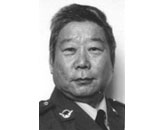 高泉
高泉
简介
高泉,1936年生,安徽蚌埠人。1956年入中央美术学院油画系,毕业后留校任教。1962年参加中国人民解放军,先后在海军和总政治部从事美术创作和美术编辑工作,曾为解放军艺术学院教授,现为中国革命军事博物馆创作室主任、中国美协会员,威海海洋画院院长。作品多次参加全国性美展。
Born in 1936 in Bengbu Anhui. He was admitted to the Oil Painting Department of Central Institute of Fine Arts in 1956 and graduated in 1961 from the painting studio directed by Professor Dong Xiwen who was well-known oil painter in China, and afterwards he retained to work as an assistant. One year later, he was transferred to the army as navy, then served successively as art worker, art editor and art professor. Now he is holding the post of chairman of Artists’ Association of Weihai, Director of the Creating Section of Beijing Military Museum and member of Chinese Artists’ Association. Since his painting “Towards Ocean” came out successful, he has created hundreds of works of art. They include the oil paintings such as “Eight Six Fighting On the Sea”, “Weather-Woman”, “Arduous years, Great Friendship”, “Establishing the Party in Company”, “A Tidal Surge of Emotion”, “Mother”, “Crossing Grasslands” and “Thirsty” etc. They also include picture poster “Long Live the Great Unity of the Nationalities Throughout the Country” and illustrations in picture-story books. Most part of his works were published or exhibited and some were awarded prizes and were collected in China and abroad.He went abroad on a tour of investigation of panorama in 1983. Between 1987 and 1990 he participated in drawing the semi-panorama “Battle in Lugou Bridge” and the panorama “Capturing Jinzhou”. These works of painting created a precedent in China, producing a greater influence at home and abroad.Recent years, he has devoted himself to drawing seas, conveying his intense emotion to the seas. He successively created over one hundred paintings of sea scenery. His selected picture album “Song of the Ocean” was published by Tianjin People’s Fine Arts Press. His representative works include “The Ocean”, “Desolating Autumn”, “Symphony of Heroes”, “Hukou on Yellow River” and others. His biographical documentary film named “The Son of Seas” was shooted by the Eight One Movie Studio of People’s Liberation Army, and was distributed throughout the country.
Born in 1936 in Bengbu Anhui. He was admitted to the Oil Painting Department of Central Institute of Fine Arts in 1956 and graduated in 1961 from the painting studio directed by Professor Dong Xiwen who was well-known oil painter in China, and afterwards he retained to work as an assistant. One year later, he was transferred to the army as navy, then served successively as art worker, art editor and art professor. Now he is holding the post of chairman of Artists’ Association of Weihai, Director of the Creating Section of Beijing Military Museum and member of Chinese Artists’ Association. Since his painting “Towards Ocean” came out successful, he has created hundreds of works of art. They include the oil paintings such as “Eight Six Fighting On the Sea”, “Weather-Woman”, “Arduous years, Great Friendship”, “Establishing the Party in Company”, “A Tidal Surge of Emotion”, “Mother”, “Crossing Grasslands” and “Thirsty” etc. They also include picture poster “Long Live the Great Unity of the Nationalities Throughout the Country” and illustrations in picture-story books. Most part of his works were published or exhibited and some were awarded prizes and were collected in China and abroad.He went abroad on a tour of investigation of panorama in 1983. Between 1987 and 1990 he participated in drawing the semi-panorama “Battle in Lugou Bridge” and the panorama “Capturing Jinzhou”. These works of painting created a precedent in China, producing a greater influence at home and abroad.Recent years, he has devoted himself to drawing seas, conveying his intense emotion to the seas. He successively created over one hundred paintings of sea scenery. His selected picture album “Song of the Ocean” was published by Tianjin People’s Fine Arts Press. His representative works include “The Ocean”, “Desolating Autumn”, “Symphony of Heroes”, “Hukou on Yellow River” and others. His biographical documentary film named “The Son of Seas” was shooted by the Eight One Movie Studio of People’s Liberation Army, and was distributed throughout the country.
